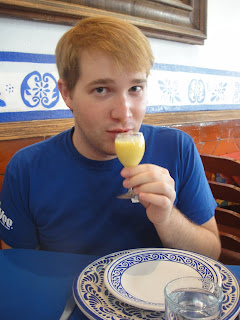I have been home, in the United Sates for a week now, actively looking for a job as well as cleaning out my bedroom of things from high school and college. I am already pretty settled into my new routine at my mother's house. However, there has been one thing nagging in the back of my mind: the draft box in my blogger account. It is full of fragmented posts about Mexico that I couldn't seem to type more than a few sentences about. So, in my determination to put everything from the past, including Mexico, behind me, I am mashing them all together into a "top 10 things I miss about Mexico" list.
#10: Cheap Beer
Mexico is not the beer guzzling nation that the United States is, it has five or six national brands of beer and it's all light and easy to drink. However, what Mexican beer lacks in flavor and body, it makes up with unique preparations and cost. By "unique preparations," I mean that you can enjoy your beer with lime, chile and/or a salted rim.(refer to #6) The cost is cheap, cheap, cheap. I once went out with 30 something Pesos in my pocket (a little over $2 U.S.) and bought 1.5 liters of beer for me and two wine coolers for Jonathan and had change when I got home.
#9: the Sun and Heat
 |
| It can be difficult to find shelter from the searing sun, especially on the beach. |
Back in February, when I was packing, and it was negative something outside, I could not imagine that it wasn't still just a little bit cold in Mexico. With that logic, I packed a jacket and a few sweaters. I wore the thinnest sweater a few times after the sun went down, but the rest remained untouched from the time I unpacked them to the time I repacked them. Many times it was too hot for clothes, let alone a sweater!
Full of hope and assumption that summer was in full swing, I returned home ready to finally put the sweaters away for the rest of the year.
Nope. The high in Kansas City the day I returned was 69, near freezing temperatures by my count. Instead of putting sweaters away, I was pulling more out. I could not keep warm enough.
Now, I yearn for those consistent, high 80 degree, sweaty days. When will they come to Kansas City?
#8: Vibrant House Colors
Here, in the mid-west, whole neighborhoods are built where every fifth house has the same design and they are all a shade of white or beige. But color is everywhere in Mexico. Houses, buildings, and interior wall colors are bright, varied and as different from one another as apples and oranges. It is not uncommon to see a row of buildings painted blue, then red, then yellow, then green, making a rainbow of buildings.
#7: Uncontrolled Traffic
 |
| Of all the buses to ride in Mexico, the party buses in Acapulco provide the most interesting ride. |
Of all the places I have been, the United States has the most regulated traffic. In my home town, in Missouri, drivers could be accused of meandering, slowing down to smell flowers on the side of the road and waving to neighbors and passers by. Even the aggressive, speed demon drivers in New York seem tame compared to the some of the shenanigans I've seen around around the world.
In Mexico there is a certain uncontrolled, free flowing rhythm to traffic: pedestrians cross the streets as they please, drivers whizz through lanes and create new ones. Buses are as ubiquitous as taxis and even though there are a few designated bus stops, you can flag one down and hop on anywhere and then be let off anytime you please, including on the high way. There are traffic laws, but they seem to go ignored as life carries on.
#6: Everything is seasoned with Chile and Limon
 |
| A whole isle in the Supermarket for dried chiles. |
 |
| Anywhere limon could be added, it has been. |
In most Western cuisine, seasoning is limited to salt and black pepper. They are part of a proper table setting as much as plates and flatware. Without them, a table feels incomplete and many Americans could not enjoy a meal without these crucial seasonings.
For a long time, I could not understand why my Mexican room mates HAD to have cream(similar to, but totally different from our sour cream), "
limon" (Mexican, or Key lime)wedges (Our yellow lemons are rare and unheard of to most Mexicans.), and a salsa on the table during a meal. Even if I had already seasoned the food with these flavors they would go get it and put more on their plate. Jonathan said the food just felt plain without being able to add his own seasoning. That is the beauty of Mexican food: everyone can personalize their food.
But these seasonings aren't just at the dinner table, they flavor everything from candy to beer. While American children dip candy sticks and suckers into flavored powders ranging from pure sugar to mind blowing sour, Mexican children dip their candy into chile powder with lime flavor.
Michelada is my newest Mexican obsession; it is a beer that has been poured into a glass rimmed with salt and chile powder, combined with lime juice and dusted with small chile flakes.


















































